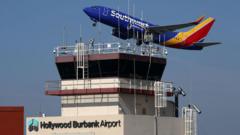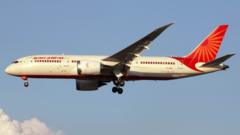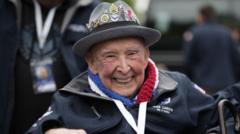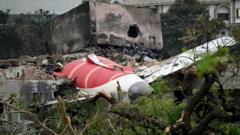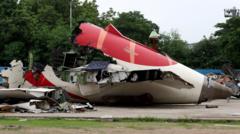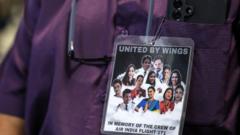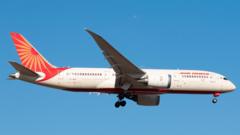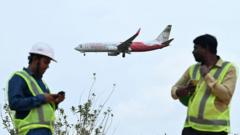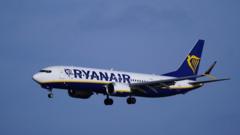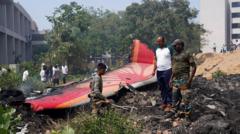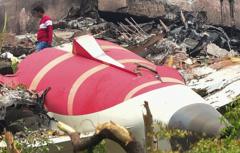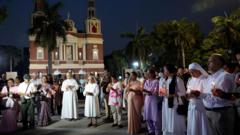A military Black Hawk helicopter collided with an American Airlines jet, resulting in both aircraft plunging into the Potomac River, prompting inquiries into safety mechanisms in place within one of the world's most monitored airspaces.
**Mid-Air Collision in Highly Controlled DC Airspace Raises Serious Safety Concerns**
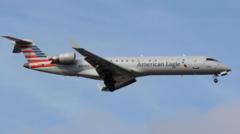
**Mid-Air Collision in Highly Controlled DC Airspace Raises Serious Safety Concerns**
In a shocking incident, a passenger plane and a military helicopter crash in Washington's tightly monitored airspace, leading to urgent calls for a review of air traffic protocols.
The aviation community is grappling with the devastating implications of a recent mid-air collision in what experts have approached as “the most controlled airspace in the world.” This tragic incident involved a U.S. Army Black Hawk helicopter and an American Airlines jet carrying 64 passengers, both of which ended up in the icy waters of the Potomac River on Wednesday evening.
The Black Hawk helicopter, with a crew of three, was reportedly engaged in a training exercise when the accident occurred moments before the passenger flight's landing at Ronald Reagan Washington National Airport. Aviation expert John Strickland highlighted the challenges of managing the airspace above one of the most politically significant cities in the world, where civilian and military activities overlap. While air traffic is substantial, he pointed out that it alone cannot account for the catastrophic encounter.
Officials noted that Washington, D.C., has a highly regulated air space, primarily due to its location near sensitive governmental sites like the White House and U.S. Capitol. Philip Butterworth-Hayes, an aviation consultant, described the region as a nexus where civilian and military aviation systems intersect, a juncture often associated with accidents.
Despite the high level of regulation, aviation experts have emphasized that the recent collision is a rarity in U.S. aviation history, the last fatal crash involving commercial aircraft occurring over a decade ago. Both aircraft were believed to be communicating with air traffic control, and preliminary analysis of radar data indicates awareness of the presence of both vessels in the busy airspace.
The Black Hawk, part of the 12th Aviation Battalion, was in the area for a routine night flying training operation. While the crew was noted to be seasoned, the crash raises questions about the operational protocols and safety measures in place during such exercises in a busy city. Retired U.S. Air Force Colonel Cedric Leighton explained that military helicopters frequently conduct these types of drills at night, emphasizing the necessity for proficient navigational skills to avoid potential collisions.
The collision triggered immediate rescue operations, while experts pondered the intricate dynamics of air traffic management in D.C. Strickland remarked on how the jet’s reduced speed during its landing phase could have compounded the incident, reducing crucial time for any emergency response.
In light of this tragic event, aviation authorities are likely to face intense scrutiny and discussions focused on enhancing airspace safety and establishing tighter flight path regulations to avoid repeat tragedies. The incident not only exemplifies the complexities of maintaining safety in a multi-layered aviation environment but also underscores the ongoing need for evolving and rigorous safety measures in air traffic management.
The Black Hawk helicopter, with a crew of three, was reportedly engaged in a training exercise when the accident occurred moments before the passenger flight's landing at Ronald Reagan Washington National Airport. Aviation expert John Strickland highlighted the challenges of managing the airspace above one of the most politically significant cities in the world, where civilian and military activities overlap. While air traffic is substantial, he pointed out that it alone cannot account for the catastrophic encounter.
Officials noted that Washington, D.C., has a highly regulated air space, primarily due to its location near sensitive governmental sites like the White House and U.S. Capitol. Philip Butterworth-Hayes, an aviation consultant, described the region as a nexus where civilian and military aviation systems intersect, a juncture often associated with accidents.
Despite the high level of regulation, aviation experts have emphasized that the recent collision is a rarity in U.S. aviation history, the last fatal crash involving commercial aircraft occurring over a decade ago. Both aircraft were believed to be communicating with air traffic control, and preliminary analysis of radar data indicates awareness of the presence of both vessels in the busy airspace.
The Black Hawk, part of the 12th Aviation Battalion, was in the area for a routine night flying training operation. While the crew was noted to be seasoned, the crash raises questions about the operational protocols and safety measures in place during such exercises in a busy city. Retired U.S. Air Force Colonel Cedric Leighton explained that military helicopters frequently conduct these types of drills at night, emphasizing the necessity for proficient navigational skills to avoid potential collisions.
The collision triggered immediate rescue operations, while experts pondered the intricate dynamics of air traffic management in D.C. Strickland remarked on how the jet’s reduced speed during its landing phase could have compounded the incident, reducing crucial time for any emergency response.
In light of this tragic event, aviation authorities are likely to face intense scrutiny and discussions focused on enhancing airspace safety and establishing tighter flight path regulations to avoid repeat tragedies. The incident not only exemplifies the complexities of maintaining safety in a multi-layered aviation environment but also underscores the ongoing need for evolving and rigorous safety measures in air traffic management.

